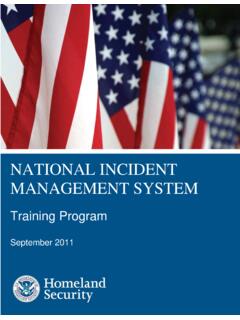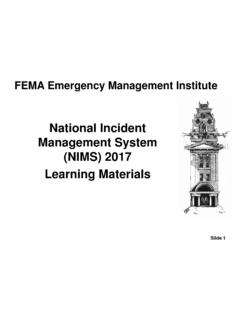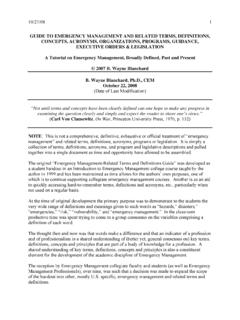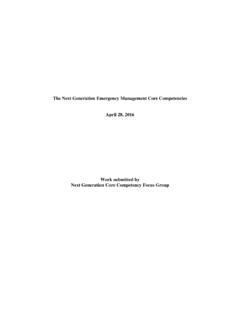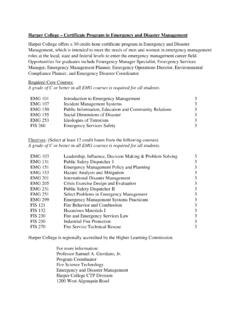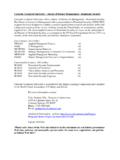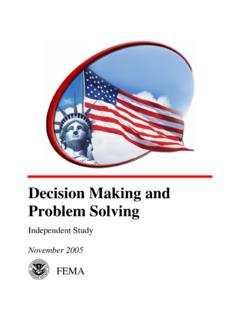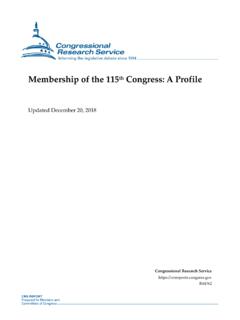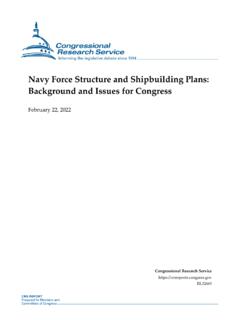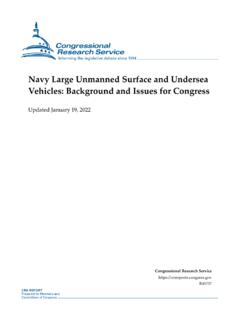Transcription of CRS Report for Congress
1 congressional research Service The Library of CongressCRS Report for CongressReceived through the CRS WebOrder Code RL33729 Federal Emergency Management Policy ChangesAfter Hurricane Katrina: A Summary of Statutory ProvisionsNovember 15, 2006 Keith Bea, CoordinatorSpecialist, American National GovernmentGovernment and Finance DivisionElaine Halchin, Henry Hogue, Frederick Kaiser, Natalie Love,Francis X. McCarthy, Shawn Reese, Barbara SchwemleGovernment and Finance DivisionFederal Emergency Management Policy Changes AfterHurricane Katrina: A Summary of Statutory ProvisionsSummaryReports issued by committees of the 109th Congress , the White House, federaloffices of Inspector General, and the Government Accountability Office (GAO),among others, concluded that the losses caused by Hurricane Katrina and otherdisasters were due, in part, to deficiencies such as questionable leadership decisionsand capabilities, organizational failures, overwhelmed preparation andcommunication systems, and inadequate statutory authorities.
2 From theseconclusions the 109th Congress revised federal emergency management policiesvested in the President; reorganized the Federal Emergency Management Agency(FEMA); and enhanced and clarified the mission, functions, and authorities of theagency, as well as those of its parent, the Department of Homeland Security (DHS).Six statutes enacted by the 109th Congress are notable in that they containchanges that apply to future federal emergency management actions. These publiclaws include the following:!Title VI of 109-295 ( 5441), the Post-Katrina EmergencyManagement Reform Act of 2006, referred to in this Report as thePost-Katrina Act;!Sections of 109-347 ( 4954), the Security andAccountability for Every Port Act of 2005, known as the SAFE PortAct;!
3 109-308 ( 3858), the Pets Evacuation and TransportationStandards Act of 2006;! 109-63 ( 3650), the Federal Judiciary Emergency SpecialSessions Act of 2005;! 109-67 ( 3668), the Student Grant Hurricane and DisasterRelief Act; and!Sections of 109-364 ( 5122), the John Warner NationalDefense Authorization Act for Fiscal Year of these statutes contain relatively few changes to federal authorities related toemergencies and disasters. The Post-Katrina Act, however, contains many changesthat will have long-term consequences for FEMA and other federal entities. Thatstatute reorganizes FEMA, expands its statutory authority, and imposes newconditions and requirements on the operations of the agency. In addition to the public laws noted above, Congress enacted supplementalappropriations, one-time waivers of requirements, and temporary extensions solelyassociated with Hurricanes Katrina, Rita, and Wilma.
4 This Report does not addresssuch measures as they do not carry long-term implications for federal emergencymanagement. This Report will be updated as developments ..1 Report Management Organizations and New FEMA: Organization and Mission ..6 The New FEMA New FEMA Missions (Generally) ..7 Administrative Recovery ..10 National Disaster Housing Strategy ..10 Continuity of Government and Operations ..11 FEMA Sub-Units and Missions ..11 Other DHS Date for Organizational Changes ..15 Emergency Management Leadership .. Positions Under the Post-Katrina Act ..16 Abolished Positions ..20 New Positions ..21 Changes to Existing Positions ..22 Qualifications ..22 Personnel and Human Capital Plan ..25 Career Paths ..26 Vacancy Rate Rotation Program ..27 Surge Capacity Force.
5 28 National Preparedness .. Preparedness System ..31 National Planning Scenarios ..32 Target Capabilities and Preparedness Grants ..33 Federal Preparedness ..33 Evacuations ..34 Education and Training .. and Training Security Training and Exercise Programs ..36 Homeland Security Education and Training Standards ..39 Stafford Act Assistance Amendments .. Federal Assistance ..40 Aid to Individuals ..40 Housing Assistance ..41 Public Assistance ..42 Definitions ..42 Grants and Loans ..43 Pilot Program ..43 Mutual Aid ..44 Hazard and Service .. Contracting ..46 Subcontracting Tiers ..46 Using Local Firms, Organizations, and Registry ..47 Oversight and and Accountability of Federal Disaster , Waste, and Abuse Prevention Training Programs ..49 Report and Guideline Development Schedule.
6 49 FEMA Secretary Requirements ..50 FEMA Administrator Requirements ..50 Federal Communications Commission Requirement ..52 Other Date ..53 Authorizations ..53 National Weather Service ..54 Education Grants ..54 Federal Judiciary ..54 National Seizure ..55 Acronyms ..56 List of TablesTable 1. Statutory Changes to Emergency Management Leadership Positions Under 109-295, 107-296, 116 Stat. 2140-2321, as amended, 6 101 et 93-288, 88 Stat. 143-164, as amended, 42 5121 et In addition to the listed statutes, Congress also enacted 4979, the Local CommunityRecovery Act of 2006 ( 109-218). Congress included in the Post-Katrina Act the textof the changes made by 109-218 as an amendment to Section 307(a)(3) of the RobertT. Stafford Disaster Relief and Emergency Assistance Emergency Management PolicyChanges After Hurricane Katrina: ASummary of Statutory ProvisionsOverviewHurricane Katrina struck Florida and the Gulf Coast states in the last days ofAugust 2005, followed within weeks by Hurricanes Rita and Wilma.
7 These disasterswill long be remembered for disrupting families, changing and ending lives, andforcing Americans to rethink vulnerability and risk assumptions. In addition to theseimpacts, the hurricanes served as catalysts for significant changes in federal policyand the organization of responsible federal entities, notably within the Departmentof Homeland Security (DHS). Most of those changes were included in Title VI of the DHS appropriationslegislation for Among other provisions, Title VI, officially titled the Post-Katrina Emergency Management Reform Act of 2006 (hereafter referred to as thePost-Katrina Act), established new leadership positions and position requirementswithin the Federal Emergency Management Agency (FEMA), brought new missionsinto FEMA and restored some that had previously been removed, and enhanced theagency s authority by directing the FEMA Administrator to undertake a broad rangeof activities before and after disasters occur.
8 The Post-Katrina Act containsprovisions that set out new law, amend the Homeland Security Act (HSA),2 andmodify the Robert T. Stafford Disaster Relief and Emergency Assistance Act (theStafford Act).3In addition to the Post-Katrina Act, Congress enacted five other statutes thathave long-term implications for the administration of federal emergency include:!Sections of 109-347 ( 4954), the Security andAccountability for Every Port Act of 2005, known as the SAFE PortAct;CRS-25 To address the needs of the disaster victims, Congress enacted legislation within weeks ofthe disasters to provide: supplemental appropriations ( 109-61 3645 and 3673), higher levels of borrowing for the federal flood insurance program( 109-65 3669), increased benefits to low-income families ( 109-68 ), expanded loans to stricken communities ( 109-88 S.)
9 1858), and other benefitsintended to provide immediate assistance to victims and their communities. For informationon such provisions see, CRS Report RS22239, Emergency Supplemental Appropriations forHurricane Katrina Relief, by Keith Bea; CRS Report RS22246, Temporary Assistance forNeedy Families (TANF): Its Role in Response to the Effects of Hurricane Katrina, by GeneFalk; CRS Report RS22344, The Gulf Opportunity Zone Act of 2000, by Erika Lunder; andCRS Report RL33174, FEMA s Community Disaster Loan Program, by Nonna A. Noto andSteven See CRS Report RL32594, Public Safety Communications Policy and CRS ReportRL32939, An Emergency Communications Safety Net: Integrating 911 and Other services ,both reports authored by Linda K. Moore.! 109-308 ( 3858), the Pets Evacuation and TransportationStandards Act of 2006;!
10 109-63 ( 3650), the Federal Judiciary Emergency SpecialSessions Act of 2005;! 109-67 ( 3668), the Student Grant Hurricane and DisasterRelief Act; and!Sections of 109-364 ( 5122), the John Warner NationalDefense Authorization Act for Fiscal Year these enactments the 109th Congress acted on findings and conclusionsreached by House and Senate investigators, White House staff, offices of federalInspectors General (especially those published by the DHS office) and theGovernment Accountability Office (GAO), among others, who evaluated theconsequences of and response to Hurricane Katrina. The investigators and theirstudies presented findings on major shortcomings, and most urged a reconsiderationof existing policies and practices.

